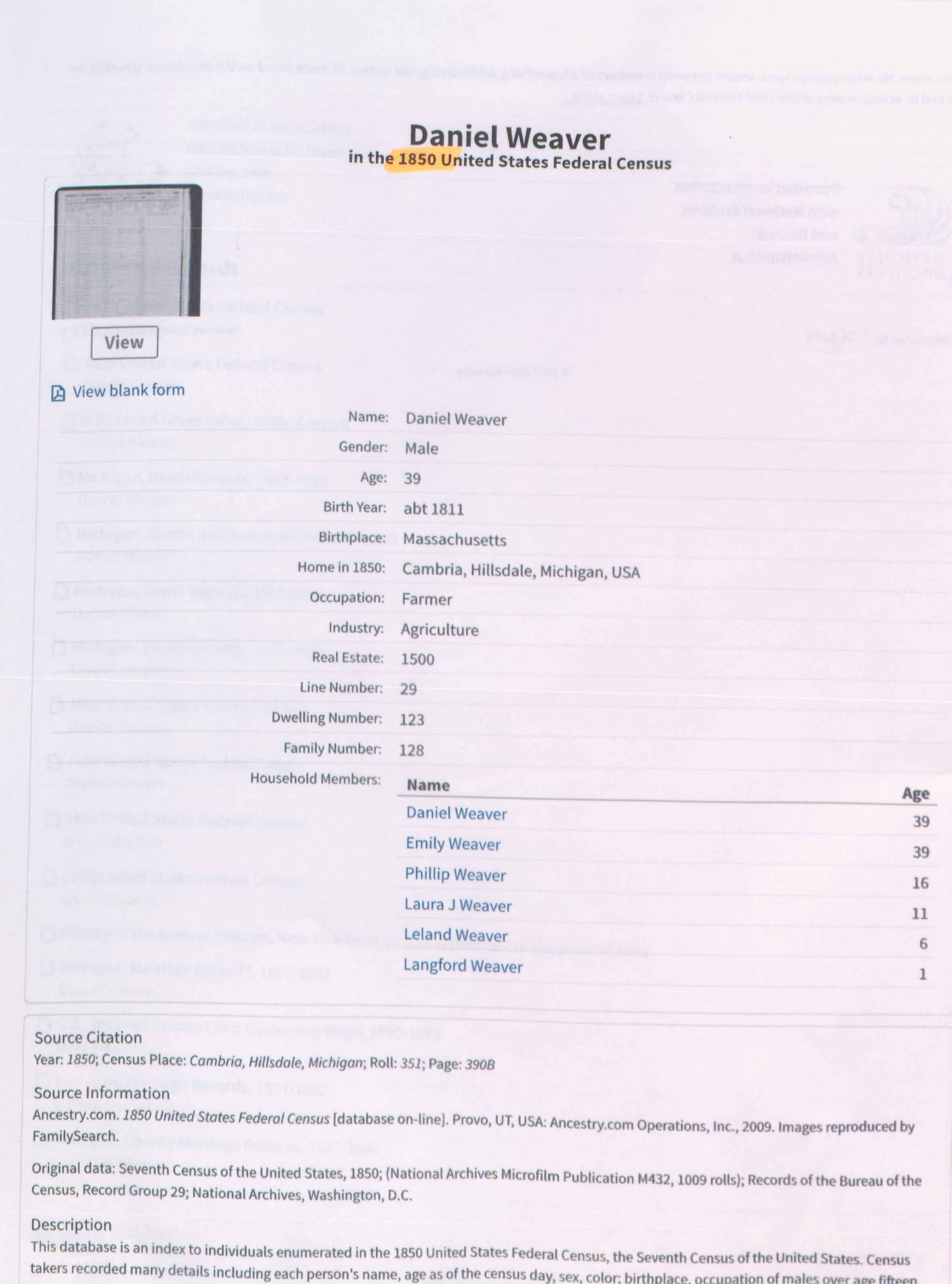
Daniel Weaver
Merchant & Miller of the Northwoods
Curator of life in the forest; Weaverville
Daniel Weaver, merchant and miller, Hesperia, was born in Berlin, Rensselaer Co., NY April 28, 1811. His parents, Stuttley and Rachel Weaver, were of English descent, and natives of Rhode Island. They both died in Michigan at an advanced age. When but an infant he was taken by his parents to Berkshire Co., Mass., where he received a district school education and worked on a farm until he was 18 years old. At that time he went to Wyoming Co., N.Y., where he was apprenticed to a carpenter and a joiner. After completing his trade he went to work for the man to whom he had been apprenticed, and remained there until he was 21 years old. In the summer of 1832 he came to Adrian, Mich., where he lived until the spring of 1838, working at his trade. March 14, 1833, he was married, in Genesee Co., N.Y., to Miss Emily A. Salisbury, daughter of Philip and Clarissa (Curtis) Salisbury, who was born in New York, Sept. 1, 1811. She was well educated and taught school several years previous to her marriage. Mr. and Mrs. Weaver returned to Lenawee County, thence to Hillsdale County, where he worked on a farm and was also employed by the county of super-intend the building of the court-house. He remained here until 1856, when he moved to this, Newaygo County, and settled on what in now Fremont Center. It was then an unbroken wilderness and not two permanent settlers within many miles. When the town first started it was named Weaverville, but has since changed to Fremont. He first built a saw-mill, then two stores and grist-mill, and other stores soon followed. He then erected a Masonic hall. It is by his earnest efforts that a wild forest has been converted into a beautiful town of 1,000 inhabitants.
In 1866 he moved into Denver Township and located on section 30, where he spent an active useful life. The first year he built a sawmill and in the second year laid out the town of Hesperia, which has grown to a village of 500 inhabitants. He does an annual business of $12,000. Dec. 25, 1874, Mrs. Weaver died, leaving four children; Philip, born Feb. 22, 1834; Laura J., Jan. 20, 1839; Leland S., Dec. 12, 1843;
Daniel L., Feb. 21, 1849; Clarissa, born Feb. 20, 1837, died in 1838; John B., born Feb. 12, 1852, died in 1853. April 27, 1879, Mr. Weaver married, in Ingham County, Mrs. Savilla (Campbell) Walling, daughter of Daniel and Mary A. (Ames) Walling, natives of New York, and she was born in Cayuga County, that State, Sept. 5, 1838. They are members of the Advent Church. Mr. W. is a member of the Masonic Lodge of Fremont, and was honored with the office of Master. He was Justice of the Peace 14 years, and Supervisor several terms. In politics he sympathizes with the Democratic Party.
Portrait and Biographical Album Newaygo Co., Michigan by Chapman Brother 1881: Pages 27-8
Article on Weaver, Founder of Fremont and Hesperia
In the winter of 1855 Daniel Weaver and Wilkes L. Stuart, after visiting areas in southern Michigan, journeyed off to look over lands in the “northwoods.” At Lansing they contacted John A. Brooks who advised them about the land around where Fremont is now located and directed them to Joslin’s cabin at Elm Corners. On this journey they reached as far as Newaygo by team. From Newaygo, they waded through deep snow toward the Joslin’s rude shanty at Elm Darling creek at the edge of what became Fremont’s location of the mill. This establishment started the lumber business in this section. And now the original pine which stood there was felled and cut into lumber.
Early in the spring of 1856, Weaver sold 100,000 feet of pine lumber to a firm in Newaygo at $22 a thousand feet. When the slashing was burned after the logs were cut, the flames could be seen and the crackle heard for many miles.
It seemed appropriate that the first school at “Weaverville” was held in the kitchen of the Weaver cabin in the summer of 1856. This lasted until later in the year when Weaver built a new home, the first frame house in what is now Fremont.
These activities fulfilled the first phase of some of the dreams of Daniel Weaver. A second phase in this area could be considered as beginning with his removal to Hesperia in 1866.
Memories Are Made of This
By Walter J. Husband
Hesperia, 1987
From the State of Michigan Historic Register:
Property Type: frame house
Historic Use: Domestic/single dwelling
Current Use: Domestic/single dwelling
Style: Greek Revival
Architect/Builder: Daniel Weaver
Significant Person: Daniel Weaver
Narrative Description The Daniel Weaver House in Hesperia is a two-story, gable-roof, clapboard -sheathed Greek Revival-style building attached to a one-story rear ell. The principal facade features a first story triangular pedimented open porch supported by flat-head round capitals, a hipped roof first story side bay, slightly raised and flat-head windows caps above lights, a boxed cornice with returns, and a central oculus beneath the gabled peak. Statement of Significance The Daniel Weaver House has historical significance for its association with a Hesperia pioneer settler. It has architectural significance as a Greek Revival-style structure and as the oldest frame residence in the village of Hesperia. Daniel Weaver {1811-1890), a native New Yorker, grew up in Berkshire County, Massachusetts. In 1832 he migrated to Adrian, where he found work as a farmer and a carpenter. Later he and his wife Emily moved to Hillsdale County where he was employed to supervise construction of the new courthouse. In 1855 Daniel Weaver settled in Newaygo County and established Weaverville. He became its first postmaster on August 23, 1856, and also built a water-powered sawmill, two stores and gristmill there. In 1866, Weaver moved to Denver Township, and opened yet another sawmill. Together with his partner John F. Cook, Weaver platted the village of Hesperia in 1867, named by Cook's daughter, Mary, for its resemblance to a garden. In the same year, Weaver completed the present Greek Revival frame residential structure. Weaver later operated one of the village's three general stores in Hesperia until his passing in 1890.
















